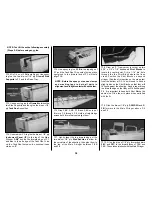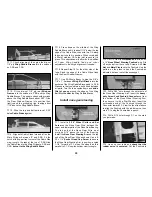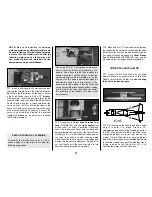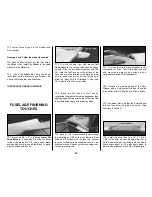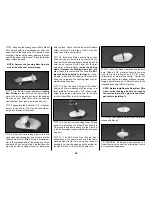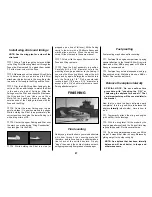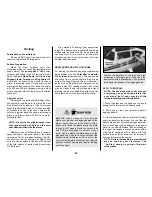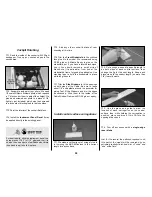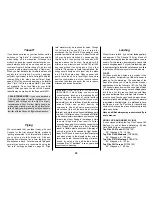
The Cessna 182 does not require much
painting to obtain the scheme shown on the box
as most of the finish is done with Top Flite
MonoKote. The only painting that is required are
the plastic parts such as the cowl, wheel pants,
fairings and wing struts. There are many other
schemes used on Cessnas but the one shown
on the box has proven to be highly visible in the
air and is “scale.”
The technique we will describe here is the
how the model pictured on the box was finished.
In general, it involves covering most of the model
with MonoKote, then priming and painting the
cowl and surface details. Make sure the
structure is smoothly sanded with
320-grit
sandpaper. Remove all dust from the structure
so the MonoKote will stick well.
Cover the aircraft with MonoKote using the
sequence below. Make sure the MonoKote is
thoroughly stuck down to the structure and all of
the edges are sealed. Use a
Top Flite
MonoKote Hot Sock
on your covering iron to
avoid scratching the MonoKote.
NOTE:
When covering areas that involve sharp
junctions, (like the tail section) cut narrow strips
(3/8” to 1/2”) and apply them in the corners
before
covering the major surfaces. The larger
pieces of MonoKote will overlap and capture
these smaller pieces. This technique also
bypasses the need to cut the MonoKote in these
areas after it has been applied.
DO NOT, under any circumstances, attempt
to cut the covering material after it has
been applied to the Fin and Stab, except
around the leading and trailing edges and
the tip. Modelers who do this often cut
through the covering and part-way into the
balsa stab skin. This can weaken the stab
to the point where it may fail in flight!
1. Tail Junction Strips (See note above.)
2. Rudder, left side
3. Rudder, right side
4. Bottom of elevators
5. Top of elevators
6. Stab bottom
7. Stab top
8. Fin, left side
9. Fin, right side
10. Fuse bottom
11. Fuse sides
12. Fuse top
13. Ends of ailerons and flaps
14. Bottom of ailerons and flaps
15. Top of ailerons and flaps
16. TE surfaces of wing (at ailerons and flaps)
17. Bottom of left wing panel
18. Bottom of right wing panel
19. Bottom of center panel (overlap covering
1/4” at the outer panels)
20. Top of left wing panel (overlap covering 1/4”
at wing LE)
21. Top of right wing panel (overlap covering
1/4” at the LE)
22. Top of center wing panel (overlap covering
1/4” at the outer panels)
Recommended covering sequence
piece of MonoKote film about 2” larger than
the area to be covered. Strip off the backing
and position the film. Tack the film down
smack dab in the middle of the Stab
.
3. Pull (as in stretch) the film toward the tip,
sealing it to the balsa from
the center out to
the tip
. Wor k out any
wrinkles and air
pockets
as you proceed with a combination of
circular and back and forth motions.
4. Do the same procedure wor king the
opposite direction
from the center.
5. Pull and seal
diagonally toward the four
corners
, always starting from the center. The
trick is to shrink out any wrinkles before you
seal the film to the surface.
6. Use a heat gun to heat and stretch the film
around curved surfaces like the stab and
r udder tips, while pulling on the excess
material. You may need to pull hard to get out
all of the wrinkles, so wear a glove if you need
to. Follow-up the heat gun with your sealing
iron to secure the bond.
The idea behind this approach (which can be
applied to any part of the model) is to
pre-
stretch the MonoKote
as it’s applied, and
remove the air pockets that can expand later
which cause the sags and wrinkles.
You can practically eliminate wrinkles caused
when the model is left out in the sun or in the
back of your car by following this technique
used in the
Top Flite
model shop.
1. Cover your sealing iron with a
Top Flite Hot
Sock
and turn the heat about 3/4 of the way to
the high setting.
2. Say we are going to cover the Stab — Cut a
Cover the structure with MonoKote
®
48
Summary of Contents for CESSNA 182 SKYLANE
Page 8: ...8 DIE CUT PATTERNS ...

